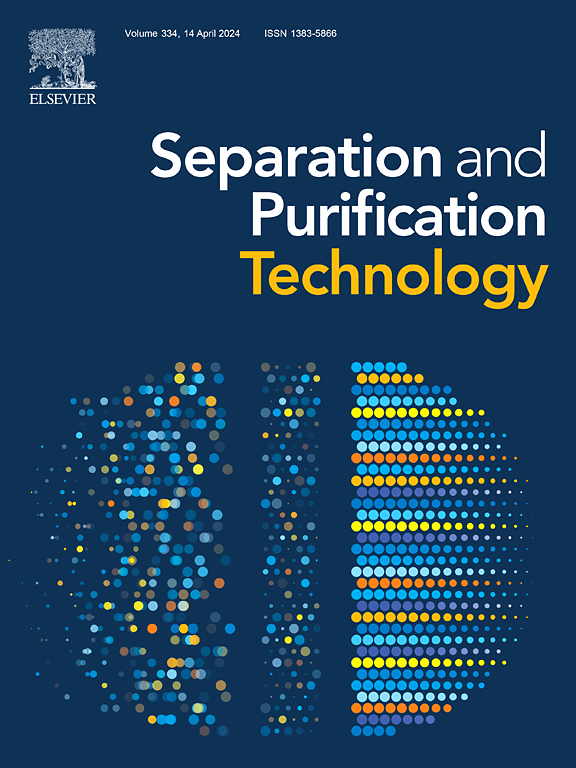Selective leaching and magnetic separation for efficient recovery of lithium and iron phosphate from Aluminum-Contaminated cathode materials of spent LiFePO4 batteries
IF 8.1
1区 工程技术
Q1 ENGINEERING, CHEMICAL
引用次数: 0
Abstract
The recovery and reuse of resources from spent lithium-ion batteries present significant potential for sustainable development and environmental protection. However, challenges remain, particularly in addressing complex issues such as the removal of aluminum (Al) impurities. This paper introduces an efficient and selective process for leaching lithium (Li) from LiFePO4 cathode material powder, even in the presence of hard-to-remove Al impurities. First, the LiFePO4 cathode material was separated from damaged Al foil current collectors using an environmentally friendly water stripping method, resulting in the active material powder containing Al impurities. In the subsequent process, a small amount of H3PO4 was used as a leaching agent, H2O2 as an oxidant, and the cathode material was subjected to mechanical activation by ball milling. After continuous optimization of all conditions, an efficient leaching of 99.5 % Li was achieved, with almost all (>99 %) Fe and Al impurities separated as precipitates. Li in the leachate was precipitated as Li2CO3 by adding Na2CO3 at 95 °C, achieving a purity of 99.2 %. A magnetic separation scheme is presented to successfully separate FePO4 from Al-containing impurities in the leaching residue. After five magnetic separation cycles, the purity of FePO4 exceeded 98.5 %. Additionally, the mechanisms of the entire reaction system were investigated using characterization methods such as laser particle size analysis, XPS, and XRD. A comprehensive economic evaluation of the entire system confirms its feasibility. This eco-friendly selective separation process shows strong potential for industrial applications and makes a valuable contribution to sustainable development.


从废LiFePO4电池铝污染正极材料中选择性浸出和磁分离高效回收磷酸锂和磷酸铁
废旧锂离子电池资源的回收和再利用为可持续发展和环境保护提供了巨大的潜力。然而,挑战仍然存在,特别是在解决复杂的问题,如去除铝(Al)杂质。本文介绍了一种从LiFePO4正极材料粉末中高效、选择性地浸出锂(Li)的工艺,即使存在难以去除的Al杂质。首先,采用环保的水提法将LiFePO4正极材料从受损的铝箔集流器中分离出来,得到含有Al杂质的活性材料粉末。在后续工艺中,以少量H3PO4作为浸出剂,H2O2作为氧化剂,对正极材料进行球磨机械活化。经过各种条件的不断优化,获得了99.5 % Li的高效浸出,几乎所有(>99 %)Fe和Al杂质都以沉淀的形式分离出来。在95 ℃条件下,加入Na2CO3将渗滤液中的Li沉淀为Li2CO3,纯度为99.2 %。提出了一种磁选方案,成功地从浸出渣中的含铝杂质中分离出了FePO4。经过5次磁选循环后,FePO4的纯度超过98.5% %。此外,利用激光粒度分析、XPS和XRD等表征方法对整个反应体系的机理进行了研究。对整个系统进行了综合经济评价,证实了其可行性。这种生态友好的选择性分离工艺具有强大的工业应用潜力,为可持续发展做出了宝贵的贡献。
本文章由计算机程序翻译,如有差异,请以英文原文为准。
求助全文
约1分钟内获得全文
求助全文
来源期刊

Separation and Purification Technology
工程技术-工程:化工
CiteScore
14.00
自引率
12.80%
发文量
2347
审稿时长
43 days
期刊介绍:
Separation and Purification Technology is a premier journal committed to sharing innovative methods for separation and purification in chemical and environmental engineering, encompassing both homogeneous solutions and heterogeneous mixtures. Our scope includes the separation and/or purification of liquids, vapors, and gases, as well as carbon capture and separation techniques. However, it's important to note that methods solely intended for analytical purposes are not within the scope of the journal. Additionally, disciplines such as soil science, polymer science, and metallurgy fall outside the purview of Separation and Purification Technology. Join us in advancing the field of separation and purification methods for sustainable solutions in chemical and environmental engineering.
 求助内容:
求助内容: 应助结果提醒方式:
应助结果提醒方式:


